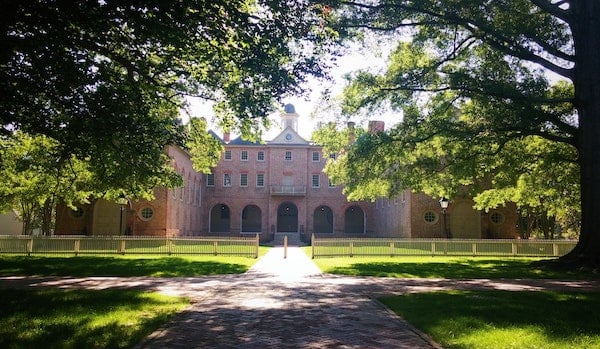Published on
The Crises Facing Today’s Colleges and Universities

It is certainly more challenging being a college professor today than in previous years, especially if one does not work at a prestigious, elite, endowed, highly selective university. Most postsecondary institutions are either nimble or at-risk. While the past year has left more than 570,000 Americans dead [1] and millions of people out of work, COVID-19 has also totally disrupted the college experience. It is estimated that 650,000 jobs (more than 13% of the American higher ed workforce) were eliminated from the start of the pandemic through the end of 2020 [2]. Moreover, 55% of faculty members have seriously considered changing careers or retiring early since March 2020 [3].
How We Got Here & the Economic Impact
However, higher ed was in a state of crisis long before the COVID-19 pandemic. Public institutions had already seen declining support from their respective state budget allocations going back to the 2008 economic downturn. Colleges and universities had already been asked to do more with less, as vacant positions often were not filled. They were also forced to raise tuition every year, sometimes in double-digit increases, and they outsourced much of their teaching to adjuncts and part-time instructors. In order to keep up with competitors and to rise in the annual rankings, institutions have also had to spend money outside of the classroom on student amenities and services to compete for traditional residential (first-time in college) students despite the rising adult learner commuter and/or online population. Additionally, college athletic programs require significant spending while not necessarily turning a profit, but they do contribute to the overall institutional recognition and branding, which can drive student enrollment.
Some tuition-driven colleges have now seen a steady decline in enrollment. People are also questioning the basic value of a college education and whether the return on investment is worth the cost or the massive debt required nowadays to earn a four-year degree. According to U.S. News & World Report, college graduates from the class of 2019 who took out student loans borrowed $30,062 on average. “That’s around $6,300 more than borrowers from the class of 2009 had to shoulder – representing a more than 26% increase in the amount students borrow” [4].
These days, there are also many more options from which families can choose, which has increased the competition to recruit and retain students. Prior to the pandemic, there were already alternative delivery options and accelerated-degree programs that certainly made higher education more flexible and convenient and, yes, more accessible. With the Morrill Acts, the GI Bill, community colleges, the Higher Education Act of 1965, etc., America had made much progress in ensuring that higher education was not just another commodity for the privileged elite.
Yet now, some parts of the country–the Northeast and the Midwest—have seen the number of high school seniors declining, and it will continue to fall over the next several years in a phenomenon known as the “demographic cliff” [5]. This makes it extremely difficult for some colleges and universities to provide a quality hi-tech/hi-touch experience for their students without having to implement austerity measures. Oftentimes, this means eliminating academic departments, certain majors, and even entire degree programs and thus cutting faculty positions—even those of tenured faculty members.
Over ten years ago an article in the Sunday Washington Post started out with these alarming words:
“Students starting school this year may be part of the last generation for which ‘going to college’ means packing up, getting a dorm room and listening to tenured professors. Undergraduate education is on the verge of a radical reordering. Colleges, like newspapers, will be torn apart by new ways of sharing information enabled by the Internet. The business model that sustained private U.S. colleges cannot survive.” [6]
A sobering but accurate assessment. Perhaps more distressing was the title of a Boston National Public Radio station segment from just one year ago, “One Third of Private 4-Year Colleges Are At High Risk Financially, Model Predicts.” The guest the reporter interviewed noted that “Many colleges will be able to help students find ways to survive this crisis, but others will need to make the incredibly difficult decision to seek a merger or close in the next few years” [7].
Faltering enrollment coupled with weakened state support has compelled entire public university systems—many of them now overbuilt for their states’ populations—to explore consolidations. A few states (i.e., Alaska, Connecticut, Georgia, Maine, Pennsylvania, Vermont, Wisconsin, etc.) have looked at solving their excess capacity problems by cutting costs via consolidating some of their two- and four-year public institutions [8]. Some struggling private colleges have explored mergers or even closings. Institutions have also had to lay off or furlough staff while others have announced salary reductions or temporary cuts to retirement contributions to offset revenue losses from COVID-19.
Industry experts note that personnel costs, not buildings, constitute anywhere between 60 to 70% of the spending by colleges, and that is why higher education relies so much on part-time instructors and overworked, underpaid adjuncts. These contingent instructors are paid a mere pittance and remain on a semester-by-semester employment contract. Such highly trained academics are often merely given a syllabus to teach without any office space or input on their own department’s decisions for curriculum or teaching matters. While some of these lay off measures protect tenured faculty from being cut, colleges still lose some talented academics due solely to their status as non-tenure eligible professors.
Additionally, some states (i.e., Missouri, Iowa, Wisconsin, etc.) have tried to pass legislation to gut or eliminate tenure at their public colleges and universities [9]. Some institutions have declared financial exigency, which enables institutions to lay off tenured faculty members under the American Association of University Professors guidelines. Other university systems, such as those in Kansas and Pennsylvania, have already declared financial exigency and enacted processes to eliminate tenured faculty positions. It is noteworthy that “in the 1970s nearly 60% of academics working in the sector were tenured or on the tenure track; today, only about a third are granted those coveted positions” [10].
Growing Skepticism & Distrust of Higher Education
To further compound things, the last several years have witnessed a steady growth in skepticism of higher education in this country, and depending on one’s political beliefs, an outright antipathy. Perhaps colleges and universities are now paying the price for political correctness, efforts to initiate civility codes to regulate language and establishing “free speech zones” on campus. Microaggressions, trigger warnings and safe zones in the classroom are now part of undergraduate education, and conservatives have seized on this free speech debate and relish using the term “snowflakes” to describe Generation Z students’ supposed fragility. Some politicians have even gone so far as to financially threaten public colleges and universities in their states for trying to promote diversity awareness and inclusion on campus and criticize specific required courses that faculty have painstakingly written and implemented to foster tolerance and social justice. Look no further than Coeur d’Alene in Kootenai County, Idaho: “For years, locals have made boogeymen out of the faculty, characterizing them as radicals with leftist agendas committed to indoctrinating students” [11].
Private higher education institutions, which do not receive any money from their states, are free to enact any curriculum changes or create new policies on their campuses as long as they do not violate basic rights. All colleges, though, have recently had to deal with the vitriolic political divide on campus and issues of free speech. Moreover, well-intentioned institutional “civility codes” encouraging courteous language while forbidding hateful or offensive words are being seen by some as suppressive. Recent efforts by both public and private colleges to promote decorum, curtail pernicious language and elevate how their students treat each other have been increasingly met with legal disputes. Using the first amendment, some argue that imposed restrictions could be used to quell legitimate political debate. Furthermore, the Foundation for Individual Rights in Education or FIRE, a non-profit Philadelphia-based education foundation whose mission is “to defend and sustain individual rights at America’s colleges and universities” [12] has successfully challenged many institutions. If the colleges do not subsequently back down, they then have to endure the ensuing negative publicity and mounting costs of lawsuits.
Faculty value their academic freedom and autonomy in deciding what they teach, how they teach it and how they conduct their classrooms. They are the subject-matter experts who worked hard to get where they are now. Yet, some politicians use tax dollars as a cudgel to get public colleges and universities to fall in line, and this is dangerous territory and perhaps a tipping point. However, one should be reminded that with the anti-communist furor of the late 1940s and early 1950s, academic freedom was no protection from universities requiring professors to sign loyalty pledges. Faculty conducting research had to agree to sign such oaths. Professors during the McCarthy Era’s Red Scare were routinely called communists and accused of un-American beliefs (whatever those are) and practices.
Controversial speakers, protests and demonstrations were a part of American higher education long before 1960s student activism and UC Berkeley’s free speech movement. However, something is different today. And yes, the majority of professors, especially in the liberal arts and social sciences, have long justly been stereotyped as liberals. Most, though, are not extreme radicals with leftist and secular beliefs. Previous polls of American adults have shown waning support of higher education despite the general consensus that a bachelor’s degree is one of the best paths to the middle class. Now there is skepticism and distrust as both conservative politicians and parents are accusing colleges and universities of indoctrinating their students.
Is this distrust just emblematic of how deeply divided the country has become? Parents understandably are concerned about what is best for their own children. For example, Democrats generally prefer a four-year degree overwhelmingly to their Republican counterparts, according to a new Gallup Poll survey commissioned by the Carnegie Corporation. Overall, 46% of parents said they would prefer not to send their children to a four-year college after high school, even if there were no obstacles, financial or otherwise. [13]. Not surprising, Florida is in the process of passing House Bill 233 which, among other things, “would allow students to record lectures without consent to support a civil or criminal case against a higher education institution” [14]. In response to the “cancel culture” the proposed bill by the Republican majority in the legislature would require the state’s public colleges and universities to survey students, faculty and staff about their viewpoints and beliefs.
Study after study has found that attending college actually “has little-to-no influence on a student’s partisan or political identity” writes Jeffrey A Sachs, Ph.D., at Nova Scotia’s Acadia University’s Department of Politics [15]. He points out that while college graduates do tend to be more liberal than non-graduates, “it is unlikely that college itself is responsible. On the contrary, someone who enters college a conservative will almost certainly leave as one. The same happens with liberals.”
Increased Scrutiny & Need for FT Engaged Professors
There have been long documented economic and social advantages of a college education that benefit both the individual and the larger public beyond higher income earnings and longer life expectancies. This is reinforced by the federal government’s longtime practice of awarding federally insured, low-interest, unsubsidized student loans to eighteen-year-old college freshmen with no collateral. It has long been considered a good investment and a means of having an educated citizenry.
College is truly a transformative experience, and students learn as much from each other in (and outside) their courses and class sessions as they do from their professors. There are social benefits to learning to think together, to solve problems together and how to disagree civilly. That is one of the great things about bringing so many people together in this common educational space. One is almost forced to encounter and deal with people who see the world through very different lenses. Professors must maintain civility on campus and in the classroom while promoting tolerance and free speech for both liberals and conservatives. If academics cannot have serious, thoughtful, intellectual discussions about controversial subjects and expose students to diverse points of view, they are doing them a disservice. Equally important, employers naturally want graduates with highly specialized knowledge, technical skills and training. However, they also want to hire graduates with broad knowledge who can communicate clearly, think critically and solve problems. Yet, perhaps most importantly, they want graduates to get along with others in an increasingly diverse, multicultural work environment [16].
Although higher ed is very much run like a business, education is after all primarily a human-interaction enterprise centered on fostering relationships, especially between faculty and the students. Faculty also learn from their students and, contrary to what many might speculate, most professors are not simply standing in front of mesmerized blank slates and lecturing. Today’s professors are not typically viewed as “fonts of knowledge” or the “sage on the stage” as students passively scramble to take down every word that is uttered. Students are questioning and interacting with their peers (and professors) and being challenged with high expectations, as faculty want them to do their best possible work. Professors do not want their students to regurgitate their words back to them, as they earnestly crave and value critical and creative thinking. Educate, yes. Indoctrinate, no.
The current tenuous state of full-time professors on college campuses has also impacted shared governance due to diminished faculty power. As a result, at many colleges, shared governance has been reduced to administrative governance, with faculty often learning of new initiatives when the administration issues a memorandum. Keeping faculty engaged, though, is a key strategy to maintaining morale, and this means professors having a meaningful role in academic decision-making.
Higher ed administrators are also starting to realize that faculty are an important part of the overall enrollment management strategy, as the quality of the teaching can surely affect student retention. This is important, as colleges and universities are now being held accountable for metrics such as their graduation rates. Working remotely and teaching exclusively online this past year has proven difficult, not to mention stressful, for faculty. This is not how American higher education once became the envy of the world.
American higher education has endured many crises (i.e., civil and world wars, segregation, 9-11, the Virginia Tech massacre, etc.) over the last 385 years since Harvard first opened its doors. There is no doubt that the academy has changed in the last several years and that the role of the professor has become increasingly uncertain. However, if colleges are to come out of these doubtful times stronger, they will need to be proactive and protect their resources, both fiscal and human. If U.S. colleges and universities are ever to regain their stature as innovative educational leaders, it will take the renewed commitment of a dedicated group of full-time professors who feel valued and appreciated on their campuses.
References
- The Johns Hopkins Coronavirus Resource Center (CRC). https://coronavirus.jhu.edu/map.html
- U.S. Bureau of Labor Statistics (February 2021).
- The Chronicle of Higher Education/Fidelity Investments survey, conducted in October 2020.
- Emma Kerr. “See 10 Years of Average Total Student Loan Debt.” US News (September 15, 2020).
- Hoover, Eric. “Demographic Cliff: 5 Findings from New Projections of High-School Graduates.” The Chronicle of Higher Education. (December 5, 2020).
- Zephyr Teachout. “A Virtual Revolution is Brewing for Colleges” The Washington Post (September 13, 2009).
- Fred Thys. “One Third of Private 4-Year Colleges Are At High Risk Financially, Model Predicts.” WBUR Boston – 90.9 FM, (May 8, 2020.
- Lee Gardner. “More States are Looking at Consolidating their Public Colleges. Does it Work?” The Chronicle of Higher Education (July 30, 2020).
- Colleen Flaherty. “Killing Tenure: Legislation in Two States Seek to End Tenure at Public Colleges and Universities.” Inside Higher Ed. (January 13, 2017).
- Scott Carlson. “Tenure’s Broken Promise: It’s Scarce, Unevenly Distributed, and Limiting Scholars’ Careers.” The Chronicle of Higher Education (April16, 2021).
- Emma Pettit. “A County Turns Against Its College.” Chronicle of Higher Education. (April 2,2021).
- The Foundation for Individual Rights in Education’s mission https://www.thefire.org/about-us/mission/
- Gallup and Carnegie Corporation of New York. Family Voices: Building Pathways from Learning to Meaningful Work (2021).
- Ana Ceballos. “Florida GOP Targets `Intellectual Diversity’ on Campus with Survey About Beliefs.” Miami Herald (April 6, 2021).
- Jeffrey Sachs. “No, Professors are not Brainwashing their Students: On the Myth of Faculty Indoctrination” Arc Digital (February 3, 2020)
- Robert Hill. “Red America, blue America: A Country (Campus) Very Much Divided.” Academic Leader (2017).
Disclaimer: Embedded links in articles don’t represent author endorsement, but aim to provide readers with additional context and service.
Author Perspective: Educator


